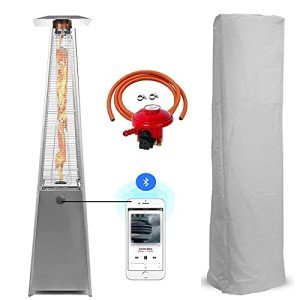The Comprehensive Guide to Gas Patio Heaters
As outdoor living becomes progressively popular, gas patio heaters have actually become a necessary aspect for extending the outdoor amusing season. Whether for a cozy evening with pals or a lively family event, these heaters offer warmth and convenience that can transform any outdoor space. This post explores the numerous elements of gas patio heaters, including their types, advantages, operational mechanics, upkeep tips, and factors to consider for purchasing one.
What is a Gas Patio Heater?
A gas patio heater is a type of heating appliance developed specifically for outdoor use. Typically sustained by see this or gas, these heaters produce heat to fight the chill of the evening air, permitting outdoor social activities to continue even under cooler temperature levels.
Kinds Of Gas Patio Heaters
Gas patio heaters come in numerous different styles, each suited for different requirements and looks. The typical types include:
Freestanding Heaters:
- These are the most typical type and are typically high, with a large base and a heater component at the top.
- They can quickly be walked around and appropriate for numerous outdoor settings.
Tabletop Heaters:
- Smaller and more compact, tabletop heaters are developed to rest on tables or other surface areas.
- They provide heat for smaller locations and are generally simpler to store.
Wall-Mounted Heaters:
- These are repaired to a wall and are a fantastic alternative for outdoor patios with restricted space.
- They use a more permanent heating option and can complement outdoor decor.
Patio Fire Pits:
- While not exclusively heaters, gas fire pits supply heat and ambiance all at once.
- They can function as a centerpiece for outdoor gatherings.
| Heater Type | Description | Best For |
|---|---|---|
| Freestanding | Tall, mobile units with a heating component on leading | Big open areas |
| Tabletop | Compact designs ideal for table surfaces | Small events |
| Wall-Mounted | Fixed systems supplying constant heat | Smaller sized patios |
| Patio Fire Pits | Integrated heating and decorative feature | Ambiance and heat |
Advantages of Gas Patio Heaters
Investing in a gas patio heater uses various advantages:
- Extended Outdoor Enjoyment: Gas heaters enable homeowners to enjoy their outdoor patios even throughout cooler months.
- Quick Heating Capability: Gas heaters warm up quickly, offering instant relief from the chill.
- User-Friendly Operation: Most gas heaters feature simple ignition controls for ease of use.
- Aesthetic Appeal: Many gas heaters are created to be aesthetically enticing, enhancing the total look of your outdoor space.
- Flexible Fuel Options: Availability of both propane and natural gas models caters to different needs and preferences.
Functional Mechanics
Gas patio heaters run by converting fuel into convected heat. Here's a streamlined breakdown of how they work:
- Fuel Source: Most gas heaters use propane or natural gas. The kind of fuel affects efficiency and availability.
- Ignition System: Most designs come with either a manual ignition (utilizing a lighter or match) or an electronic ignition (push-button).
- Heating Element: Once ignited, gas streams through a burner, where it is combusted to produce heat. Convected heat spreads from the heating aspect.
- Heat Diffuser: Some heaters have a reflector to help disperse warmth more equally throughout a larger location.
Fuel Comparison
| Fuel Type | Pros | Cons |
|---|---|---|
| Propane | Portable, extensively available | Needs tank replacement/refill |
| Gas | Affordable if connected to a supply | Setup more complicated |
Maintenance Tips for Gas Patio Heaters
Appropriate care will extend the life of gas patio heaters. Here are some necessary upkeep suggestions:
- Regular Cleaning: Keep the heater clean from dirt and debris. Frequently wipe down the surface areas.
- Inspect Gas Supply Lines: Check for leaks or fractures in the gas lines. Usage soapy water to detect leakages by observing bubbles.
- Seasonal Checks: Before using a heater, examine all elements and repair work or change any damaged parts.
- Storage: During off-seasons, save the heater in a dry place or cover it for protection.
- Professional Servicing: Consider a professional check-up annually, specifically for natural gas models.
Considerations When Purchasing a Gas Patio Heater
When selecting a gas patio heater, keep the following elements in mind:
- Heating Capacity:
- Measured in BTUs, a greater BTU rating provides more heat.
- Size and Weight:
- Depending on the space available and whether the heater needs to be portable.
- Material:
- Stainless steel heaters offer durability and resistance to rust and corrosion.
- Design:
- Choose a style that matches your outdoor decor.
- Safety Features:
- Look for automated shut-off functions or safety tilt valves to prevent accidents.
FAQs
Q: Are gas patio heaters safe to use?A: Yes
, when used according to the manufacturer's guidelines and security standards, gas patio heaters are safe. Constantly ensure appropriate ventilation.
Q: How long can one propane tank last?A: A standard 20 lb
propane tank can last anywhere from 8 to 30 hours, depending upon the heat setting. Q: Can gas patio heaters be used indoors?A: No,
gas patio heaters are designed for outdoor use only due to the risk of carbon monoxide gas accumulation in enclosed spaces. Q: Do gas patio heaters require assembly?A: Most freestanding models need standard assembly
, while tabletop and wall-mounted options may need more
specific assembly. Gas patio heaters are an appealing solution for those aiming to enhance their outdoor experiences throughout the year.
By understanding the different types, benefits, and operational mechanics, prospective buyers can make informed decisions that line up with their needs. Proper upkeep and security considerations will guarantee that these heaters stay effective and safe, supplying comfort to outdoor gatherings for lots of seasons to come. With cautious selection and care, a gas patio heater can become a precious addition to any outdoor living space.

